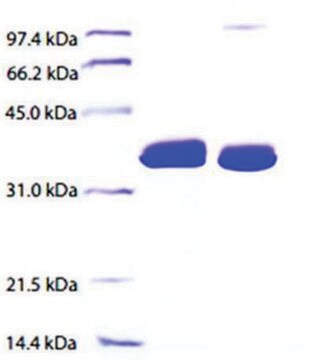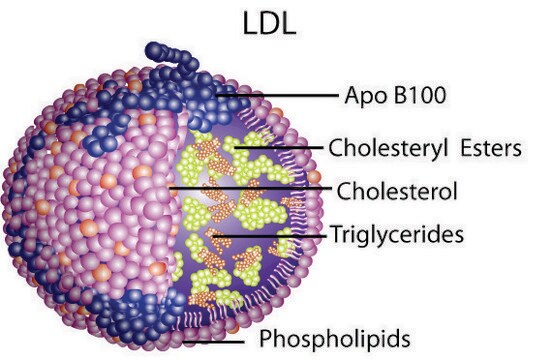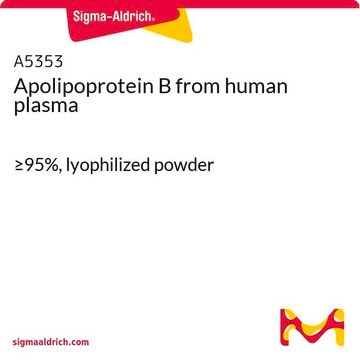178468
Apolipoprotein E, Human Plasma, Very Low-Density Lipoprotein
Native apolipoprotein E from human plasma. A major component of VLDL and IDL. Serves as a major cholesterol carrier. Essential for the normal catabolism of triglyceride-rich lipoprotein constituents.
Synonim(y):
Apo E
Zaloguj sięWyświetlanie cen organizacyjnych i kontraktowych
About This Item
Kod UNSPSC:
12352202
NACRES:
NA.25
Polecane produkty
Poziom jakości
Próba
≥95% (SDS-PAGE)
Formularz
liquid
producent / nazwa handlowa
Calbiochem®
warunki przechowywania
OK to freeze
avoid repeated freeze/thaw cycles
Warunki transportu
wet ice
temp. przechowywania
−20°C
Opis ogólny
Native apolipoprotein E from human plasma. A component of VLDL and a subclass of HDL. Serves as a ligand for LDL receptors, where it participates in the transport and redistribution of cholesterol and other lipids. Also functions in immunoregulation, cell growth, and differentiation. Present in normal plasma at concentrations of 50 µg/ml.
Native apolipoprotein E from human plasma. A component of VLDL and of a subclass of HDL. Present in normal plasma at concentrations of 50 µg/ml. Serves as a ligand for LDL receptors, where it participates in the transport and redistribution of cholesterol and other lipids. Also functions in immunoregulation and cell growth differentiation. Inhibits mitogen-induced T-lymphocyte proliferation and modulation of smooth muscle cell differentiation.
Opakowanie
Please refer to vial label for lot-specific concentration.
Ostrzeżenie
Toxicity: Standard Handling (A)
Postać fizyczna
In 50 mM NH₄HCO₃, pH 8.0.
Uwaga dotycząca przygotowania
Prepared from plasma that has been shown by certified tests to be negative for HBsAg and for antibodies to HIV and HCV.
Rekonstytucja
Following initial thaw, aliquot and freeze (-20°C).
Inne uwagi
Kelly, M.E., et al. 1994. Cell Immunol. 159, 124.
Mahley, R.W. 1988. Science 240, 622.
Rall, S.C., et al. 1986. Methods Enzymol. 128, 273.
Mahley, R.W. 1988. Science 240, 622.
Rall, S.C., et al. 1986. Methods Enzymol. 128, 273.
Informacje prawne
CALBIOCHEM is a registered trademark of Merck KGaA, Darmstadt, Germany
Oświadczenie o zrzeczeniu się odpowiedzialności
RESEARCH USE ONLY. This product is regulated in France when intended to be used for scientific purposes, including for import and export activities (Article L 1211-1 paragraph 2 of the Public Health Code). The purchaser (i.e. enduser) is required to obtain an import authorization from the France Ministry of Research referred in the Article L1245-5-1 II. of Public Health Code. By ordering this product, you are confirming that you have obtained the proper import authorization.
Ta strona może zawierać tekst przetłumaczony maszynowo.
Kod klasy składowania
11 - Combustible Solids
Klasa zagrożenia wodnego (WGK)
WGK 1
Temperatura zapłonu (°F)
Not applicable
Temperatura zapłonu (°C)
Not applicable
Certyfikaty analizy (CoA)
Poszukaj Certyfikaty analizy (CoA), wpisując numer partii/serii produktów. Numery serii i partii można znaleźć na etykiecie produktu po słowach „seria” lub „partia”.
Masz już ten produkt?
Dokumenty związane z niedawno zakupionymi produktami zostały zamieszczone w Bibliotece dokumentów.
Jian-Ying Zhou et al.
Journal of proteome research, 9(10), 5133-5141 (2010-08-12)
The discovery of biomarkers for neurodegenerative diseases will have a major impact on the efficiency of therapeutic clinical trials and may be important for understanding basic pathogenic mechanisms. We have approached the discovery of protein biomarkers for amyotrophic lateral sclerosis
Joanna L Richens et al.
International journal of molecular epidemiology and genetics, 5(2), 53-70 (2014-06-25)
Previous mass spectrometry analysis of cerebrospinal fluid (CSF) has allowed the identification of a panel of molecular markers that are associated with Alzheimer's disease (AD). The panel comprises Amyloid beta, Apolipoprotein E, Fibrinogen alpha chain precursor, Keratin type I cytoskeletal
Andrzej S Pitek et al.
PloS one, 7(7), e40685-e40685 (2012-07-26)
It is now well established that the surface of nanoparticles (NPs) in a biological environment is immediately modified by the adsorption of biomolecules with the formation of a protein corona and it is also accepted that the protein corona, rather
Nasz zespół naukowców ma doświadczenie we wszystkich obszarach badań, w tym w naukach przyrodniczych, materiałoznawstwie, syntezie chemicznej, chromatografii, analityce i wielu innych dziedzinach.
Skontaktuj się z zespołem ds. pomocy technicznej








